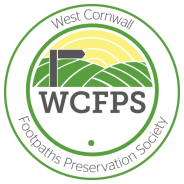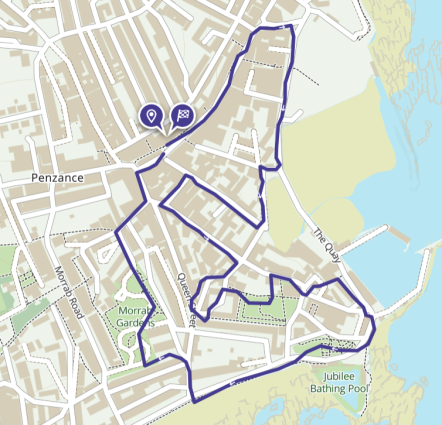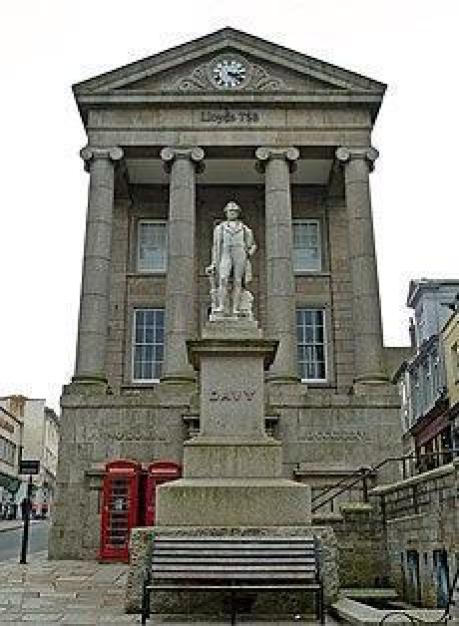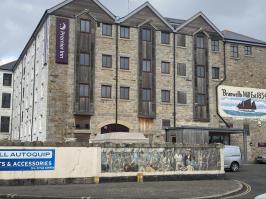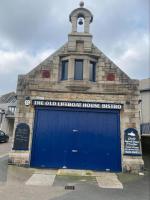Penzance 2 Historic & Curious Penzance Part 1
Walk Details
|
|
Contains OS data © Crown copyright and database right 2023 |
This is the first part of a stroll around Penzance hopefully taking in some features that you may not have seen before.
Start at the Humphry Davy statue in Market Jew Street (See Note 1).
We start our walk by going down Market Jew Street, walk on the right hand side and look up and admire the different architecture above the shops, especially numbers 3 & 4 above “Trespass”.Keep walking down the right hand side of Market Jew Street.
Cross over towards “Supervolt” electrical stores and turn left into, Wood Street, probably one of the shortest streets in Penzance.
Turn right at the end of Wood Street into Bread Street. This street used to contain most of the abattoirs of Penzance and still contains “The Crown”, a pub and microbrewery.
Have a quick diversion, straight on into Victoria Square - a delightful little corner of Penzance.
Return to Bread Street and continue downhill. At the crossroads turn right into Adelaide Street where you will pass Seasalt, now a national business, started here by Mr Chadwick, then called General Clothing Store.
At the bottom of Adelaide Street cross over and walk down Albert Street towards the car park (See Note 2)
At the corner turn right and walk on the right-hand pavement and, at the “Old Lifeboat House” (now a restaurant,See Note 3) turn right and then left onto Abbey Slip. Just as you start climbing the slope, look up to you right above the slip to “Ship Ashore”(See Note 4)
Go up the slip or the steps and turn right at the top into New Street. A little way up New Street,(approx 100 m) on the right, is Foster Place, another contender for Penzance shortest street.
Continue up New Street to number 35 on the left. The house has a heritage plaque to commemorate John Divane VC. Near the top of New street is St Michaels Housing complex with three plaques that explain its importance to Penzance.
Just before the Exchange, turn left into Princess Street. This street contains some impressive granite buildings, one being a Masonic lodge, the large, light blue building on the left.
Turn Left into Chapel Street. There’s much to look at in Chapel street, like the Egyptian House, Union Hotel, Turks Head pub and Admiral Benbow pub, with the pirate on the roof!(See Note 5)
At the Admiral Benbow crossroads turn right into Voundervour Lane.
Continue bearing to the right past Voundervour House and then slightly left, On your right, above a door of an old National school, is a bust of John the Baptist.(see note 6 ) The old name for Penzance used to be “Pensans”, the Cornish for “holy head”. John the Baptists was an old representation of a holy head - the holy seer was beheaded at the request of Salome after the dance of the seven veils.
Continue on the opposite side to John the Baptist and turn sharp left Into Regents Square. These 1830’s houses are architecturally stunning.
Continue through the square and turn right into a back lane with the Churchyard showing at the end, opposite house number one, Regent Square. Walk through the churchyard and turn left in front of the church (whose architect, Charles Hutchens, was a St Buryan man) into Chapel Street again.
Turn right and cross over before turning left into Dock Lane. (Dock lane is a left turn in front of the Steamship offices).
Go down the steps to the right of The Longroom (the old customs house) and, as you descend these steps look up to your right and see the beautiful stained glass round window of the old Trinity House depot. Continue along the lane to arrive at the harbour.
Turn right towards the Dolphin inn (See Note 7). Take the cobbled lane behind it and cross the road at the end, bearing slightly left onto the main road and then turn immediately right into St Antony Gardens. Go up some steps and ahead of you is a granite fountain ( See note 8). It appears the main bowl is carved out of one piece of granite. This fountain once stood outside St Johns Hall and is made of Lamorna Granite.
Walk out of St Anthony Gardens towards the promenade. Follow the promenade, the only promenade in Cornwall, until you reach Queen Street. You will know when, as Queen Street is written on the floor of the promenade.
Cross the road into Queen Street and walk past The Navy Inn public house. Turn slightly left as you pass the Taj Mahal restaurant and go straight past Coulsons Terrace up a back lane. Enter Morrab gardens (see note 9) through the metal gate. Have a wander around and then walk up through the gardens, pass Pengarth and out of the top gate.
Follow the lane to Parade Street, turn right, past the Acorn (see note 10) and Honeypot tea rooms, and then turn left at the Co-op into Chapel Street.
Walk up to the top of Chapel Street which brings you to Lloyds Bank and the start.
You may want to think about doing Part 2 of this walk as it starts at the same spot.
Sir Humphrey Davey was born close to this statue, his most remembered achievement was the miners safety lamp, but he also discovered sodium and potassium.
Behind him is the Market House built in 1837, this is announced in a granite carving on the front. One has to wonder at the skill of the stone mason, carving this out of granite, a not inconsiderable hard rock, by hammer and chisel.
Note 2
To your left is now a Premier Inn, but this building has had many incarnations. It started as a mill “Branwells Mill”.
On your right is “Wharf House” built in 1872. Today the area to your right is a shopping centre and housing, and further on flats, but this was originally the gas works, with retort house and gasometers.
At one time the car park opposite was a harbour and coal was unloaded for the production of gas for Penzance.
Note 3
The old lifeboat House was opened in 1885 and contained an eight oared boat the “Dora”.
The bell tower you see on top was used to summon volunteers in an emergency. The station finally closed in 1917.
